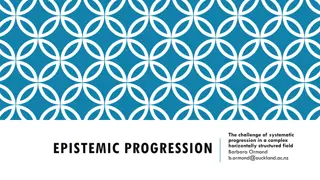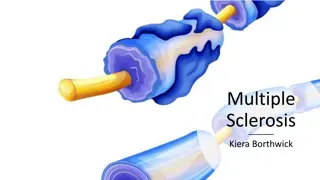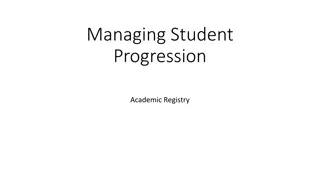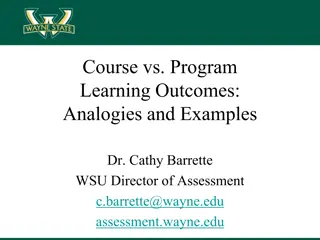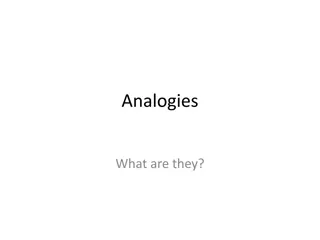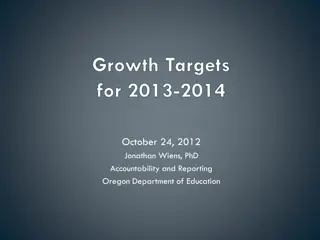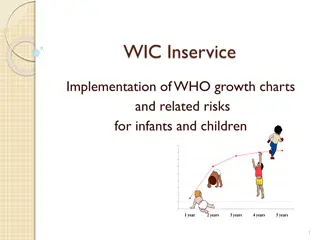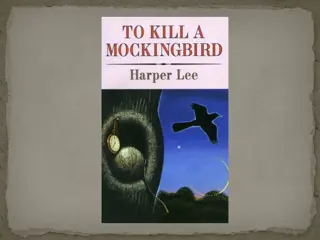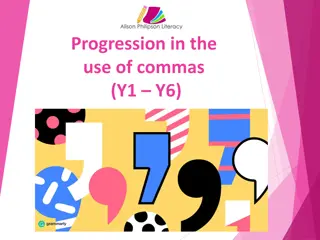Understanding Educational Growth Progression Through Analogies
Explore the analogy of a four-lap, one-mile footrace to grasp the concept of maintaining relative position in educational growth. Grade-equivalent scores and standard scores are compared to illustrate student progress over time, with vivid imagery and explanations provided to enhance understanding.
Download Presentation

Please find below an Image/Link to download the presentation.
The content on the website is provided AS IS for your information and personal use only. It may not be sold, licensed, or shared on other websites without obtaining consent from the author. Download presentation by click this link. If you encounter any issues during the download, it is possible that the publisher has removed the file from their server.
E N D
Presentation Transcript
ANNUAL PROGRESS: MAINTAINING THE SAME RELATIVE POSITION A Year s Growth in a Year s Time?
Grade-Equivalent Scores Corresponding to Standard Scores of 120, 110, 100, 90, and 80 by Spring Grade Norms
KTEA-II Form A Reading Comprehension Alan Kaufman & Nadeen Kaufman. Circle Pines, MN: Pearson Assessment, 2004 Analogy with a Four-Lap, One-Mile Footrace
Ron Dumont & John Willis 2/28/07 Revised by Susan Morbey 11/25/07 Analogy stolen from Gerald M. Zelin, Esq. (but experienced by John Willis running against Olympic Gold Medalist Frank Shorter et al. c. 5/2/64)
Ed. Evals. 5/15/09 Ron Dumont & John Willis 6
SS = Standard Score PR = Percentile Rank GE = Grade-Equivalent Score Note: Grade-Equivalent Scores are not equal units. You cannot add or subtract them as we have done here! Don t do that! 1 mile = 4 laps around track
Start of First Lap Start/Finish Line 4 laps = 1 mile 1 lap = 1 year of school 4 laps = grades 1 through 4
SS 120 PR 91 GE 3.2 SS 110 PR 75 GE 2.5 SS 100 PR 50 GE 1.8 range = 2.2 years SS 90 PR 25 GE 1.3 SS 80 PR 09 GE 1.0 End of First Lap: Quarter-Mile Spring of Grade 1 Start/Finish Line SS = Standard Score PR = Percentile Rank GE = Grade-Equivalent Score
End of First Lap End of first grade (grade 1.9). Red (Shorter) is in first place (grade equivalent 3.2). Blue, Violet, and Turquoise are in second, third and fourth places. Green (Willis) is in last place (grade equivalent 1.0). Shorter is already 2.2 grades ahead of Willis [3.2 1.0 = 2.2].
0 SS 120 PR 91 GE 4.9 SS 110 PR 75 GE 3.6 SS 100 PR 50 GE 2.8 range = 3.4 years SS 90 PR 25 GE 1.9 SS 80 PR 09 GE 1.5 End of Second Lap: Half-Mile Spring of Grade 2 SS = Standard Score PR = Percentile Rank GE = Grade-Equivalent Score
Note: Grade-Equivalent Scores are not equal units. You cannot add or subtract them as we have done here! Don t do that! International Reading Association (1982). Misuse of grade equivalents: resolution passed by the Delegates Assembly of the International Reading Association, April 1981. Reading Teacher, January, p. 464. Smith, M. III (2009). The Hippocratic Oath and grade equivalents (Metametrics Position Paper 1330L). Retrieved from http://www.lexile.com/m/uploads/grade-equivalents/HippocraticOathGradeEquivalents.pdf Willis, J. O. (1977). Overall Achievement Test - Cumulative Evaluation Reflecting Educational Ability Level (OAT-CEREAL). NH Personnel and Guidance Journal, 6, 1, 9.
End of Second Lap End of grade two (grade 2.9). Red (Shorter) is still in first place (grade equivalent 4.9). Blue, Violet, and Turquoise are still in second, third and fourth places. Green (Willis) is still in last place (grade equivalent 1.5). Shorter is now 3.4 grades ahead of Willis [4.9 1.5 = 3.4].
SS 120 PR 91 GE 6.5 SS 110 PR 75 GE 5.2 SS 100 PR 50 GE 3.7 range = 4.5 years SS 90 PR 25 GE 2.9 SS 80 PR 09 GE 2.0 End of Third Lap: Three Quarters of a mile Spring of Grade 3 SS = Standard Score PR = Percentile Rank GE = Grade-Equivalent Score
End of Third Lap End of grade three (grade 3.9). Red (Shorter) is still in first place (grade equivalent 6.5). Blue, Violet, and Turquoise are still in second, third and fourth places. Green (Willis) is still in last place (grade equivalent 2.0). Shorter is now 4.5 grades ahead of Willis [6.5 2.0 = 4.5].
SS 120 PR 91 GE 7.5 SS 110 PR 75 GE 6.1 SS 100 PR 50 GE 4.8 range = 5.1 years SS 90 PR 25 GE 3.4 SS 80 PR 09 GE 2.4 End of Last Lap: One Mile Spring of Grade 4 SS = Standard Score PR = Percentile Rank GE = Grade-Equivalent Score
End of Fourth Lap End of grade four (grade 4.9). Red (Shorter) is still in first place (grade equiv. 7.5) and has finished. Blue, Violet, and Turquoise are still in second, third and fourth places. Green (Willis) is still in last place (grade equiv. 2.4) and is still running. Shorter is now 5.1 grades ahead of Willis [7.5 2.4 = 5.1].
Four Laps = 1 Mile We all made some progress each year. Each of us completed each lap and covered more or less another quarter-mile. We all kept the same relative positions. Shorter (Red) remained in front with Standard Score 120. Violet remained in the middle with Standard Score 100, and Willis (Green) was always fifth with Standard Score 80.
Four Laps = 1 Mile However, after each lap, as average Violet passed the end-of-lap mark, Shorter (Red) moved farther ahead of average (Violet) and much farther ahead of below-average Willis (Green).
Grade-Equivalent Scores at End of Each Grade 8.0 SS 120 7.0 SS 110 Grade-Equivalent Score 6.0 5.0 SS 100 4.0 SS 90 3.0 SS 80 2.0 1.0 0.0 1 2 3 4 11/14/08 ASAIF 21 End of Grade __
Note: Grade-Equivalent Scores are not equal units. You cannot add or subtract them as we have done here for this illustration! Don t do that!
Maintaining the same standard score does mean maintaining the same relative position in your group. If that standard score is 100 (scaled score 10, T score 50, percentile rank 50, NCE 50, etc.), then you are making about one year s progress each year and maintaining the same relative position.
If that standard score is less than 100 (scaled score 10, T score 50, percentile rank 50, NCE 50, etc.), then you are making less than one year s progress each year and maintaining the same relative position.
We are here defining one years progress as the average progress measured by a normed test over one year for a student achieving precisely average scores. That amount is also 1.0 years of grade equivalencies. Grade-equivalent scores are not equal units.
If that standard score is greater than 100 (scaled score 10, T score 50, percentile rank 50, NCE 50, etc.), then you are making more than one year s progress each year and maintaining the same relative position.
Final Caveats Grade-equivalent scores become ever less meaningful as students progress through the grades. Grade-equivalent scores are not equal units, so they cannot be added, subtracted, multiplied, nor divided (which pretty much eliminates averaging). If one insists, one may find the median.
Final Caveats The average student s basic reading, writing, and math skills do not improve dramatically in high school. However, high-school students with weak basic reading, writing, and math skills can (and, we believe, absolutely should be taught to) increase the levels of those skills.
Final Caveats Most individually administered achievement tests do not deeply test the specialized, advanced skills mastered by the average student during high school. Work samples; classroom tests; examiner-made criterion-referenced tests; curriculum-based assessment (CBA or CBM); and collaboration with teachers may be needed.
Final Caveats Many teaching programs include lists of specific skills to be taught. Some even include end-of-unit tests or other criteria for demonstrating mastery. These can be used (or adapted to be used) as one way of measuring progress if the specific skills are defined with sufficient clarity and specificity.
Note: Grade-Equivalent Scores are not equal units. You simply cannot add or subtract or average them as we have done here for this illustration! Don t do that!




